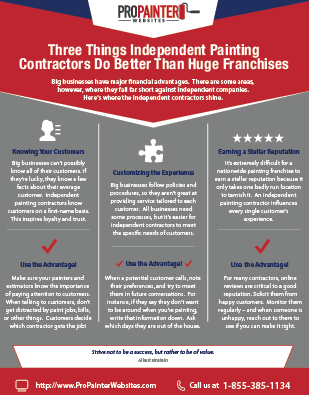Variables To Think About For Business Outside Painting By Season: Important Info You Need To Have
Variables To Think About For Business Outside Painting By Season: Important Info You Need To Have
Blog Article
Web Content Develop By-Carlson Decker
When you're planning a business outside paint job, seasonal factors can make or damage your results. You'll want to consider how temperature level and moisture impact paint application and drying times. Selecting the ideal period can ensure your paint sticks effectively and lasts longer. However which seasons are really the most effective for this kind of job? Let's discover the crucial elements that can affect your project's success.
The Impact of Temperature on Paint Application
When you're intending a commercial exterior paint job, the temperature can considerably impact just how well the paint sticks and dries.
Ideally, you want to repaint when temperatures vary in between 50 ° F and 85 ° F. If it's also chilly, the paint might not cure effectively, causing issues like peeling or fracturing.
On minneapolis interior painting contractor , if it's as well hot, the paint can dry too quickly, protecting against correct bond and leading to an uneven coating.
You must also consider the time of day; early morning or late afternoon uses cooler temperatures, which can be a lot more desirable.
Constantly check the supplier's referrals for the certain paint you're making use of, as they commonly offer support on the ideal temperature level variety for optimal outcomes.
Humidity and Its Impact on Drying Times
Temperature isn't the only environmental aspect that affects your business outside paint project; humidity plays a considerable role also. High humidity degrees can reduce drying out times substantially, affecting the overall quality of your paint job.
When the air is saturated with wetness, the paint takes longer to heal, which can result in concerns like bad bond and a greater risk of mold development. If you're painting on an especially humid day, be planned for prolonged delay times between coats.
It's important to monitor regional weather and strategy appropriately. Preferably, go for moisture degrees between 40% and 70% for ideal drying out.
Maintaining these factors in mind ensures your job stays on track and provides a long-term finish.
Best Seasons for Commercial Outside Paint Projects
What's the best time of year for your industrial exterior painting tasks?
Spring and early autumn are typically your best bets. Throughout these seasons, temperatures are moderate, and humidity degrees are frequently lower, creating suitable problems for paint application and drying out.
Prevent summer season's intense heat, which can cause paint to dry too quickly, leading to poor attachment and finish. Likewise, https://people.com/politics/favorite-first-lady-white-house-portraits/ can impede proper drying out and curing, running the risk of the longevity of your paint work.
https://erickblucm.mybuzzblog.com/14159076/searching-for-the-best-home-painters-discover-the-keys-to-achieving-a-magnificent-home-remodeling-and-raising-your-residential-property-value-by-as-much-as-7 for days with temperatures in between 50 ° F and 85 ° F for optimal results. Keep in mind to inspect the regional weather prediction for rain, as damp conditions can destroy your project.
Preparation around these aspects ensures your painting task runs efficiently and lasts longer.
Conclusion
Finally, preparing your industrial exterior painting projects around seasonal factors to consider can make a substantial difference in the end result. By scheduling work during the ideal temperature levels and humidity levels, you'll ensure far better adhesion and drying out times. Bear in mind to watch on neighborhood weather report and choose the correct time of year-- spring and early autumn are your best bets. Taking these actions will certainly help you achieve a resilient and professional coating that lasts.
